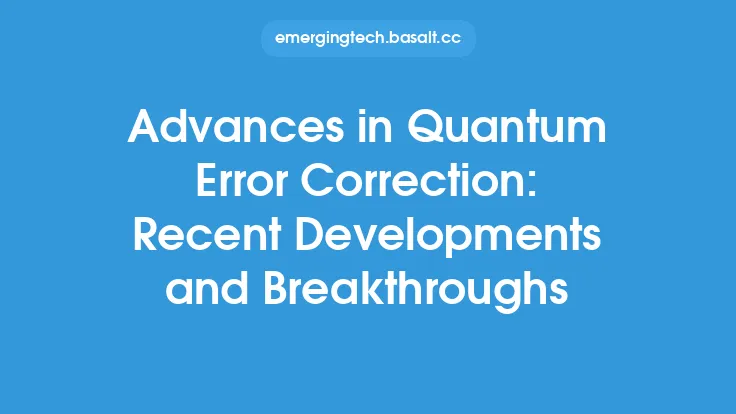Quantum computing has the potential to revolutionize the way we process information, but it is not without its challenges. One of the major hurdles in the development of quantum computing is the issue of error correction. Quantum computers are prone to errors due to the fragile nature of quantum bits, or qubits, which are the fundamental units of quantum information. These errors can arise from various sources, including noise in the quantum gates, decoherence, and measurement errors. As a result, developing robust methods for error correction is essential for large-scale quantum computing.
Introduction to Quantum Error Correction
Quantum error correction is a set of techniques used to protect quantum information from errors caused by decoherence and other quantum noise. The principles of quantum error correction are based on the concept of redundancy, where the information is encoded in a way that allows it to be recovered even if some of the qubits are affected by errors. Quantum error correction codes are designed to detect and correct errors by adding redundancy to the quantum information. These codes can be broadly classified into two categories: quantum error correction codes that use a discrete set of quantum states, and those that use a continuous set of quantum states.
Types of Quantum Error Correction Codes
There are several types of quantum error correction codes, each with its own strengths and weaknesses. Some of the most common types of codes include surface codes, Shor codes, and concatenated codes. Surface codes are a type of topological code that uses a two-dimensional array of qubits to encode quantum information. Shor codes, on the other hand, are a type of block code that uses a combination of bit and phase flip corrections to protect quantum information. Concatenated codes are a type of code that uses multiple layers of encoding to achieve high levels of error correction.
Quantum Error Correction Threshold
The quantum error correction threshold is a critical parameter that determines the maximum error rate that can be tolerated by a quantum error correction code. Below this threshold, the error correction code can correct errors and maintain the integrity of the quantum information. Above this threshold, the error correction code fails, and the quantum information is lost. The threshold value depends on the type of code and the level of noise in the quantum system. In general, the threshold value is around 1-2% for most quantum error correction codes.
Fault-Tolerant Quantum Computing
Fault-tolerant quantum computing is a critical aspect of quantum error correction. It involves designing quantum algorithms and quantum error correction codes that can tolerate errors and maintain the integrity of the quantum information. Fault-tolerant quantum computing requires the development of robust methods for error correction, as well as the design of quantum algorithms that can adapt to errors. Some of the key techniques used in fault-tolerant quantum computing include error correction with feedback, dynamic decoupling, and noise-resilient quantum control.
Challenges in Quantum Error Correction
Despite the significant progress made in quantum error correction, there are still several challenges that need to be addressed. One of the major challenges is the development of scalable quantum error correction codes that can be implemented in large-scale quantum systems. Another challenge is the need for more efficient methods for error correction, as the current methods can be computationally intensive. Additionally, there is a need for more robust methods for characterizing and mitigating noise in quantum systems.
Opportunities in Quantum Error Correction
While there are several challenges in quantum error correction, there are also many opportunities for innovation and advancement. One of the most significant opportunities is the development of new quantum error correction codes that can achieve higher levels of error correction with fewer resources. Another opportunity is the integration of quantum error correction with other quantum technologies, such as quantum simulation and quantum metrology. Additionally, there is a growing need for quantum error correction in emerging applications, such as quantum communication and quantum cryptography.
Experimental Implementations of Quantum Error Correction
Several experimental implementations of quantum error correction have been demonstrated in recent years. These implementations include the demonstration of quantum error correction codes in ion trap quantum computers, superconducting qubits, and optical quantum systems. Some of the notable experiments include the demonstration of a 3-qubit quantum error correction code using ion trap quantum computers, and the demonstration of a 9-qubit surface code using superconducting qubits. These experiments have shown the feasibility of quantum error correction in various quantum systems and have paved the way for the development of more advanced quantum error correction techniques.
Theoretical Models of Quantum Error Correction
Theoretical models of quantum error correction are essential for understanding the behavior of quantum error correction codes and for developing new codes. Some of the most common theoretical models include the quantum circuit model, the stabilizer formalism, and the density matrix formalism. The quantum circuit model is a theoretical framework for modeling quantum computation and quantum error correction. The stabilizer formalism is a mathematical framework for describing the behavior of quantum error correction codes. The density matrix formalism is a theoretical framework for modeling the behavior of quantum systems in the presence of noise and errors.
Conclusion
Quantum error correction is a critical aspect of quantum computing, and it has the potential to revolutionize the way we process information. While there are several challenges in quantum error correction, there are also many opportunities for innovation and advancement. The development of robust methods for error correction, the design of fault-tolerant quantum algorithms, and the integration of quantum error correction with other quantum technologies are some of the key areas of research in this field. As quantum computing continues to evolve, the importance of quantum error correction will only continue to grow, and it is likely to play a critical role in the development of large-scale quantum computing systems.





